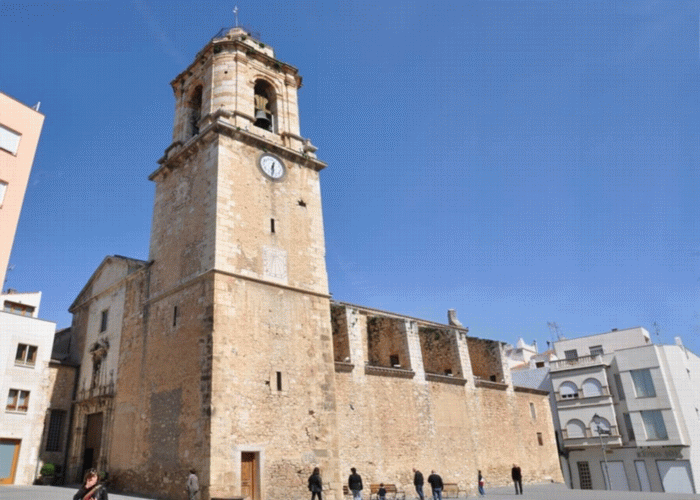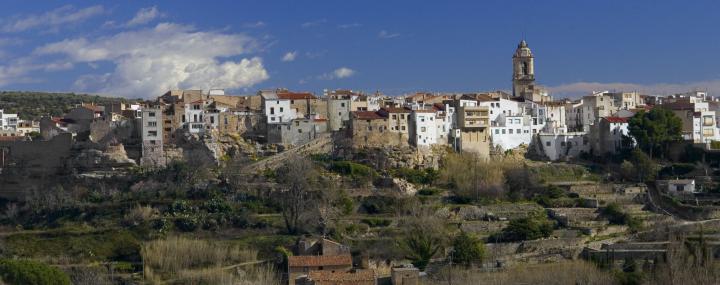|
A little review of the History of the Town
 
The first written references of the existence of a nucleus of population organized in the place
Currently occupied by the municipality of La Sénia are from the beginning of the thirteenth century. This does not mean
That the population of the area is so modern. The presence of settlers is documented by remains
Materials from the prehistoric time.
The zone of the sénia has been occupied since ancient times. Cave paintings cave
And the La Tenalla cave are the testimonies of a seasonal nomadism of small human groups that
Was general to all ports in Neolithic times. In these paintings Levinas saw the fauna of the time, and
-brujos social types, hunters, bailarines- and elements of female and male attire are distinguished, so
As scenes of honey collecting activities, of propitiatory practices for the hunting and selection of animals.
The period of broce-iron, between the end of the second millennium BC and early first,
There was a set of very dense population in the lower parts of the Ports. The walled town of
Senioles, at the end of the Sénia, was part of this constellation of settlements that links the axes of communication
(Rivers-ramblas-ravines ...) between the shore lands and those of the interior vertebrates by the rivers Matarranya and Algers.
These routes continued to be of vital importance during the period of the colonizers and the Roman era.
They were linked to the Mediterranean trade lines of Phoenicians, Greeks, metals and other raw materials.
In epoch andalusi the territory of the Sénia was linked to the City of Tortosa, head of a demarcation
That has the origin in the ecclesiastical division of the territory in time tardor romana.La Arab occupation is materialozo
At the end of the second decade of the eighth century. Of epoca andalusi we have archaeological record of the term. The
Necropolis of Los Dumenges and of the more of the Torril allow us to speak of an area that was vertebrava in relation
To the path of penetration to the Ports which communicated to others the "Husun" of the castle of Uldecona and
Benifassa castle.
After the conquest of Tortosa by the Christian troops by Ramon Berengurer IV, Year 1148, the lands of the
Present district of the Montsia were granted mainly to the order of the Hospital. The year 1232 the Castella de Amposta
Made donation of the term and place of the Sénia to Guillem de Moragues, so that as administrator he would be in charge
To organize the population with citizens mostly arrived from the Old Catalunya.
The population chart dates from 1236 and was a reference of 21 neighbors or families as the first
Local people.
The inhabitants of the Sénia were subjected to a good handful of censuses and charges derived from the feudal system,
Which requisitioned almost half of the harvest of each family. Also mills and kilns, together with
Rights, were under state control. The hospitalers gave permission to build in a mill
which it remains active until well into the twentieth century.
It is the one that is known today like the moli of the Maco. The rights and duties of the settlers were regulated
In the beginning by the Customs of Ulldecona. At the end of the thirteenth century these were replaced by those of Tortosa.
The year 1553 the village was accounting for 88 fires, which suggests that the number of inhabitants to the last
Sixteenth century would not exceed 800.
The agricultural activity and waste of the time must be added the industrial activity derived from the approval
Of hydropower. In the beginning most of establishments were dedicated to grind corn - mills of arina -
And the refining of blankets from the textile industry of the Ports of Morella and Maestrat. From very soon
The use of water for irrigation or for industrial approval generated major conflicts between the different
Populations of the river of the roy of the Sénia and between the feudal powers of the moment, especially the troops
Montesa and military hospital. In relation to these litigations in 1332 the bishop of Tortosa at that time
Berenguer de Prats, issued an arbitration ruling regulating the use of river flow. In this way the problem
abanzada was solved until modern times. One important source of income was forest exploitation.
So the exploitation of the wood has been an activity practiced within the market economy at least
From middle age.
At the low Median age the Sénia got to be constituted in independent region of the one of Ulldecona, with which maintained
Continuously litigation of jurisdictional types. The first proper commander took possession in the late 1950s
Of the fifteenth century. During the Catalan civil war 1462-1472, against Juan II, the Sénia rest in principle the territory
Dominated by the Generalitat. After two besieged by the army, the year 1466 capitulated in exchange for the
Promise that their traditional privileges would be respected and recognized for all purposes of separation.
Definite of the command of Ulldecona. And I happened to depend directly on the Castellania of Amposta. Little time
Then in the second quarter of the sixteenth century, it was incorporated into Miranbel's command. At that time the Sénia
It was still a place of passage. It is example the visit that tube in November of 1429 of the king Alfons Magnamim.
When the Catalan courts were reunited in Tortosa, Aragonese in Vallderrobles and Valencian in San Mateu, the king
Establishes the Chancellery in Benifassa and travels from one meeting to the other, while the queen was staying in Beseit.
The year 1553 the village was accounting for 88 fires, a fact that suggests that the number of inhabitants in the last years
Of the sixteenth century would not exceed 300.
Altogether, the XVI century was difficult in all Catalonia and in our region. Years of dryness are repeated
(1566-1571), frost (1573-1596) and pest (1527, 1547, 1572).
The seventeenth century is passed without a major change of orientation. The difficulties of the previous century continue,
With the addition of lobster pests and, especially, the bubonic plague of the 1950s.
During the war of the Reapers (1640-1652) the area suffered much in part because of the strong social confictibidad.
La Sénia, like the rest of towns located south of the coll de Balaguer, was segregated from the rest of Catalonia
to be kept under Castilian mandate.
The modern growth of the population began from the 20's of the eighteenth century. Of the 335 inhabitants surveyed
The year 1719 was changed to 1026 in the year 1830. The main reason was the expansion of dry farming.
The main products are continued being olive, wheat and carob. A second growth factor
Was the increase of the industrial activity related to the hydrological approval of the river of the Sénia,
Especially the paper industry.
In the second half of the nineteenth century Carlist ideology remained in the village. And coexisted with the rest
Of trends of the moment, especially the liberal and the Republican and democratic inscipientes. In the aspect
Demographic the population continued with a strong growth throughout the century. Of the 1,026 inhabitants
In 1900 the population had increased to the 3,452 neighbors. From the economic point of view the actibidad
Agricultural and industrial (mills and paper factories) continued to coexist although progressively the second
Hiva taking the push that would characterize it in the century XX.
The civil war of 1936-1939 affection to the population of dramatic way the town maintained itself under the republican mandate until
At the end of April 1938. With the occupation of the Francoist troops in the field of aviation that had been
Built by the republican government, was to pass into the hands of the Legion Condor, name of the German allied forces that helped Franco.
The last few years have been characteristically important the arrival of foreign population attracted by the demand of hand
Of industrial work, almost all
From Eastern Europe.
There are some things missing in order not to lengthen the history so much.

Pulsando sobre el Pajaro pasa a la pagina de Inicio
|



 Català:
Català:
 Castellà:
Castellà:



